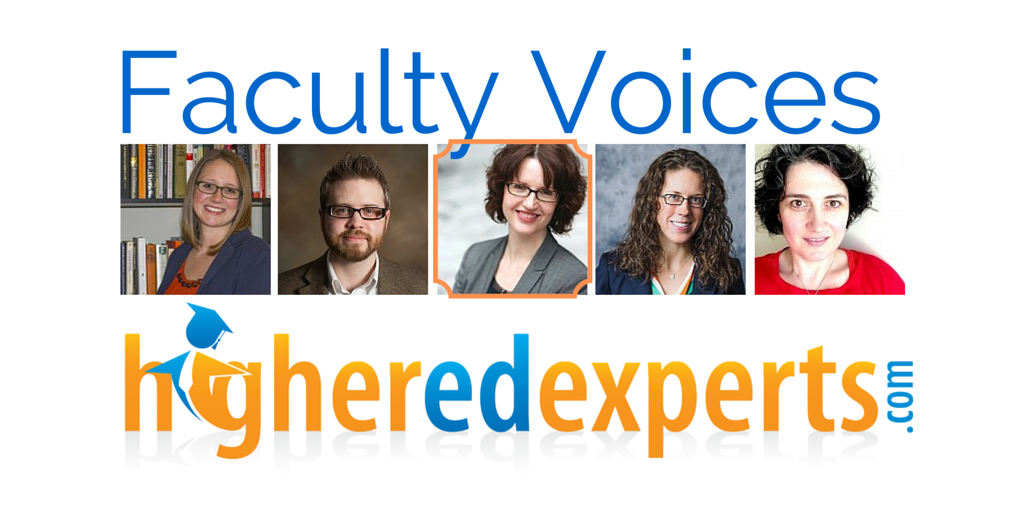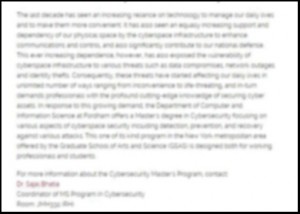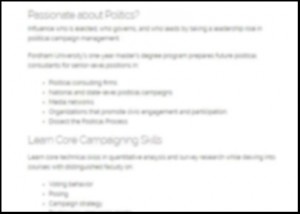
Get ready for a test!
Which of the following web pages would you rather read?
OPTION A

OPTION B

I know you can’t read them, but trust your gut here. Which looks the most appealing?
This is a version of the “squint test” as it’s known in design circles. The squint test helps designers step away from their designs and have a little more objectivity when looking at their creations. By obscuring the actual content and reducing the thing to shapes and layout, a designer can see how elements relate to one another and what the focal point of the design is. In web design, it’s often used to make sure the call to action is clear.
On the Web, everybody squints.
But everyone subconsciously performs the same technique on multiple webpages every day. Just a glance at the layout of the content and the vast majority of us make a split-second decision to stay or go.
 Now I’m not talking about long-form journalism or the reading we might do online for pleasure. I’m talking about the content we seek out to help us complete whatever web task we’ve given ourselves, as well as the content that seeks us out in the form of targeted emails and other marketing. Supposedly this content has all of 3 to 5 seconds to capture us.
Now I’m not talking about long-form journalism or the reading we might do online for pleasure. I’m talking about the content we seek out to help us complete whatever web task we’ve given ourselves, as well as the content that seeks us out in the form of targeted emails and other marketing. Supposedly this content has all of 3 to 5 seconds to capture us.
And so going back to my original question, even when the actual content is obscured, which page are you more likely to give a chance? I’m guessing it’s Option B.
Online readers read. Web users scan.
What’s easily recognizable in Option B is that it is scannable content. Large subheadings, short sentences, and bulleted lists ensure that we’ll be able to digest this page quickly and that our eyes will keep moving down the page. In Option A—what we like to call “the wall of text”—our eyes are likely to get stuck, mired somewhere between the third and fourth sentences.
Online we’re constantly switching between scanning and reading modes. During my morning commute, I read an article in the New York Times and scan through Facebook. At work, I scan emails about upcoming events and read through a creative brief. Scanning is less demanding. Reading requires more energy.
Problems arise when we are expecting to do one thing and find ourselves asked to do the other.
How often have you abandoned a page because you’re having to read when you had hoped to find the thing you were looking for quickly? And vice versa. Have you ever settled into something prepared to read and been disappointed to find yourself scanning because it is not as engaging as you had hoped?
Have some there there.
I would like to clear up one misperception about scannable content though. Scannable does not mean insubstantial. I personally find the page which consists of nothing but short bulleted statements as unappealing as a wall of text. There has to be some there there.
Google seems to be favoring longer-form content these days—no doubt it’s easier to fit keywords into 1500 words then it is 150 words—but keyword matching is but one part of the algorithm which considers quality factors as well. Plenty of landing pages secure a top spot with virtually no copy but very healthy backlinking and traffic.
But substance isn’t just about impressing a search engine, it’s about fulfilling the needs of your audience and establishing authority. For institutions of higher education especially, authority comes from expertise as well as the ability to communicate that expertise—in others words, from a command of language.
And everyone likes some variety. Sentences of different sizes; paragraphs of different lengths; bullets, em-dashes, question marks and other punctuation make for a more lively visual presentation.
Good web writing? Sometimes you know it when you see it.
Meet the Faculty: Donna Lehmann
Higher Ed Experts is a professional online school for digital professionals working in universities and colleges.
When you take a professional certificate course with us, you get a chance to upgrade your skills by working on your projects, interacting with classmates just like you and getting detailed personalized feedback from your instructor.
 Donna Lehmann is the Senior Director of Marketing and Communications at Fordham University. She has taught many higher education professionals the art and science of writing for the web and social media.
Donna Lehmann is the Senior Director of Marketing and Communications at Fordham University. She has taught many higher education professionals the art and science of writing for the web and social media.
She holds a bachelor’s degree in English and master’s degree in American Literature from Kansas State University and completed coursework toward a PhD at the University of Delaware. She is also a graduate of the Higher Ed Experts web writing certificate program.
Donna teaches Higher Ed Expert’s 4-week online course on Web Writing for Higher Education.
Tags: Higher Ed Experts Faculty, Higher Ed Marketing, Higher Ed News